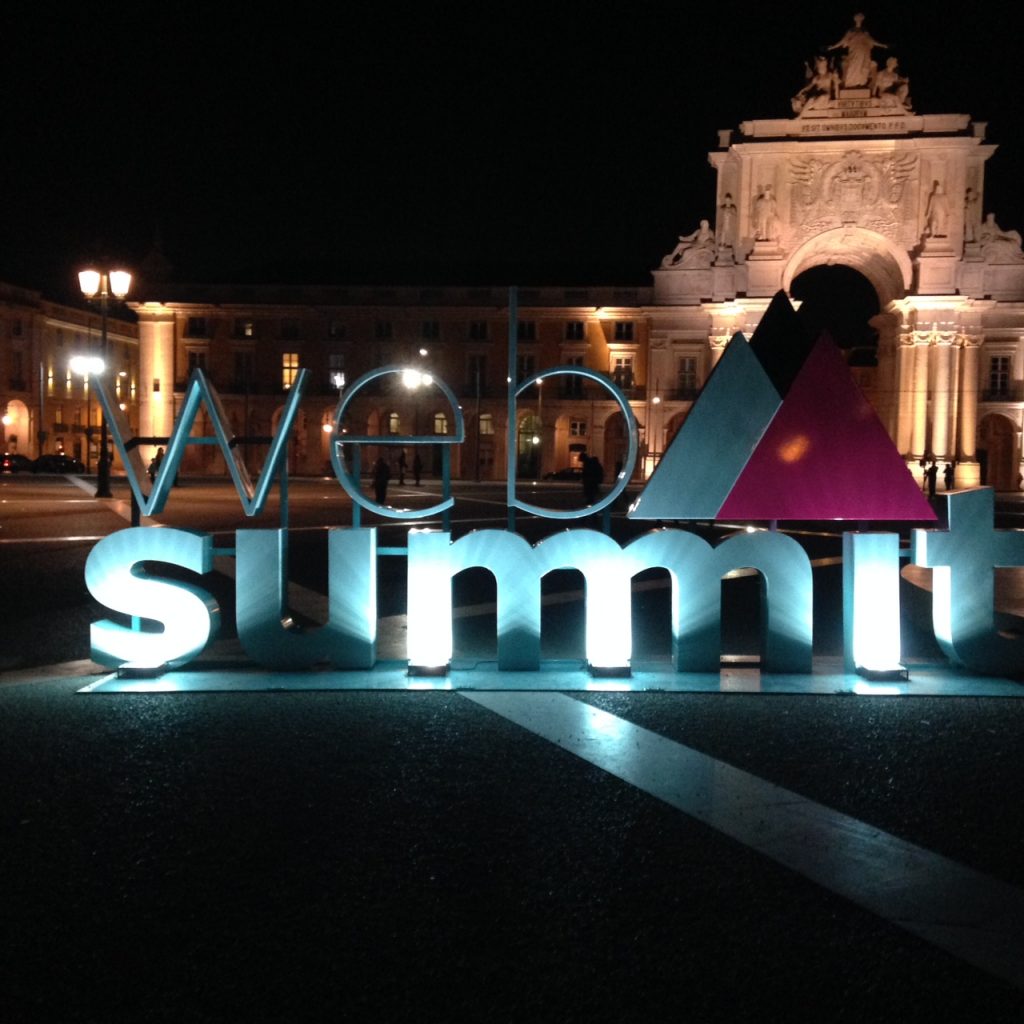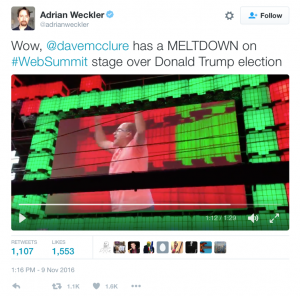Report from the Web Summit in Lisbon
 The Web Summit, dubbed the largest technology marketplace event in Europe, is a renowned meeting place for Web innovators and start-up companies. Web Science Institute directors Susan Halford and Leslie Carr attended to discover what the business community have planned for the future of the Web.
The Web Summit, dubbed the largest technology marketplace event in Europe, is a renowned meeting place for Web innovators and start-up companies. Web Science Institute directors Susan Halford and Leslie Carr attended to discover what the business community have planned for the future of the Web.
Paddy Cosgrave certainly knows how to put on a show. His first Web Summit, held in a hotel outside Dublin in 2009, attracted fewer than 400 participants. Fast forward to 2016, here we are in Lisbon with 54 000 people, almost all of whom (it seems) have turned up for the opening ceremony. Hardly surprising perhaps, since the line-up includes Jose Manuel Barossa (until recently President of the European Commission) chatting with Mogens Lykketoft (President of the United Nations General Assembly) about ‘New Realities’ in the world economy; and the Prime Minister of Portugal, António Costa, who chooses the occasion to announce a €200m investment fund for tech industry start-ups in his country. Oh, and Joseph Gordon Levitt: welcomed on stage by a stadium-scale display of mobile phone torches. This, surely, is the rock and roll of the Web world, even if Bono has to email us all (individually) to report his ‘chagrin’ that he can’t make it, this time around. Never mind that the opening ceremony venue ‘only’ holds 15 000 people, the huge outdoor screens set up in the balmy Lisbon evening (well, we had just flown from 8°C in London) mean that we can all see and hear what’s going on. And only add to the feeling that we are part of something big, exciting and – frankly – a little overwhelming.
Cut to the first day of the Web Summit proper. MC Paddy – channelling a Zuckerberg CEO style-vibe in T-shirt, jeans and trainers – tells us that he is overwhelmed too as he introduces Mike Schroepfer, CTO of Facebook, here to set the tone with ‘Ten Years from Now’, looking into the future for the global giant. The future, it seems, is drones beaming a Wi-Fi ‘backbone in the sky’, neural nets delivering improved artificial intelligence (trained in part by all those photographs uploaded to Facebook every minute of every day) and enhanced virtual reality that might mobilise undamaged cells in paraplegics to enable previously impossible levels of rehabilitation. Only the latter prompts applause from the audience. We are starting to feel a little less overwhelmed. This talk of the future is less than revolutionary. In fact, it’s what Facebook have been investing in for years. But it is presented with an implicit conviction that, somehow, these already-made decisions will still be relevant in 10 years and that they will lead to social progress, although the relationship between technological development and the complex world of politics, economics and social divisions isn’t touched on. To be fair, futurology has a troubled history. Those who predict paradigmatic changes are more than often wrong. And those of us of a more theoretical bent know that the future is a mixture of path dependency and unpredicted outcomes, contingent on often serendipitous points of intersection between social, economic, political and technical actors. Hold that thought, we’ll come back to it in the near future.
This is not to say that there’s no attention to social issues at the Web Summit. The ‘Future Societies’ stage has a full 3-day programme and attracts a packed audience of several hundred for every debate, covering issues from the filter bubble to gender inequality, corporate social responsibility to data ethics, privacy and ‘rallying tech for refugees’. The significance of this should not be underestimated. It would have been easy not to bother or, at least, unsurprising if this space for debate had been absent at what is – essentially – a business fair. Its presence shows how inextricable technical innovation is from questions of inequality, power and social change and its popularity surfaces an undercurrent of progressive commitment that has long been present in the technical innovation community (however often this is side-lined by more conventional business imperatives). Nowhere was this progressive sentiment more apparent than in the impassioned call made by Dave McClure (founder of 500 Start-Ups) for delegates to protest at the emerging news that Donald Trump had become 45th President Elect of the United States, captured in a tweet that became the most liked and retweeted of the whole conference. Not least in the light of these recent events, the Future Societies stage will be just as important for the Web Summit in 2017. If not more so.
It would have been easy not to bother or, at least, unsurprising if this space for debate had been absent at what is – essentially – a business fair. Its presence shows how inextricable technical innovation is from questions of inequality, power and social change and its popularity surfaces an undercurrent of progressive commitment that has long been present in the technical innovation community (however often this is side-lined by more conventional business imperatives). Nowhere was this progressive sentiment more apparent than in the impassioned call made by Dave McClure (founder of 500 Start-Ups) for delegates to protest at the emerging news that Donald Trump had become 45th President Elect of the United States, captured in a tweet that became the most liked and retweeted of the whole conference. Not least in the light of these recent events, the Future Societies stage will be just as important for the Web Summit in 2017. If not more so.
In this context, the analytical edge of the debate would be hugely improved by drawing in research expertise and evidence, including from the interdisciplinary field of Web Science research, which offers the concepts, methods and data to transform enthusiastic conversations between tech leaders into powerful claims about new technologies and social change. It was notable that only one academic took part in the Future Societies debates. Indeed few academic researchers were at the Summit. Yes, it’s quite expensive and no it doesn’t count towards an academic CV. But few other events in the world offer such access to the tech industry and in linking research to the Futures Societies debate it is possible – at least – that we are pushing at an open door.
However, the Futures Societies stage is a side-show. The purpose proper of the Web Summit is for start-ups to show-case their businesses to potential investors and to network intensively with others in their business. This is where the scale of the event comes from. Over the three days, almost 1000 businesses display their wares across three giant warehouses. There is a palpable buzz in the crush of bright and mainly very young people, all more than ready to evangelise about their products and services. No wonder: the Summit might be their best big chance for commercial breakthrough, especially as the organizers provide subsidised tickets to the newest of the start-ups and arrange a schedule of meetings with advisors, peers and investors to support their development.
So what can we learn from this vast collection of emergent businesses about the future of the Web? Remarkably, there is little here to suggest that the future Web will look very different from the Web we have today. Most of the start-ups fall into one of three categories: new online retail offerings and the logistics to support them; new social media platforms for increasingly niche markets (a platform for people with tattoos ‘and those who love them’); and algorithmic processes to improve business productivity. The Web is ‘black boxed’: a taken-for-granted infrastructure on which business innovation will rest: not itself the subject of innovation, rather finished and fixed. For those who study the Web (us, as Web Scientists) this is so deeply counterintuitive that it demands reflection. The Web that we have in 2016 looks very little like the Web of 2006 and nothing at all like the Web as it was originally envisaged in 1989. Certainly the core principles of HTTP, HTML and URIs persist but each has changed its form and – more broadly – both the social and technical composition (or, we might say, the ‘sociotechnical’ composition) of the Web have changed radically over the intervening years. Large scale content and advertising delivery networks are replacing simple Web servers; mobile apps and conversational devices are replacing Web browsers. It’s a bit early to assume that the pioneering days of a changing Web are over, and we shouldn’t expect its future to look like an eternal rollout of rehashed commercial services, the by-product of the business superstructure that has been built on top of it and no more. Rather, we suggest that new technologies and new social realities will continue to fundamentally transform the Web infrastructure and disrupt the businesses that depend on it.
And we need to think now about the direction of travel here. As the Web has grown to become the largest sociotechnical infrastructure in human history it has become entwined with the social and economic future of the planet. True, fewer than half of the world’s population currently use the Web, but this will change rapidly over coming years. And in any case, the Web already has implications for everyone, whether they use it or not, shaping the global economy, influencing political regimes and enabling new power blocs (Microsoft, Google, Facebook) that seek to manage the future for all of us. If we treat its future as unknowable or even inevitable then we abdicate responsibility for the future and that, surely, is not what we want to do.
These comments may seem to take us a long way from reviewing the start-ups present at the Web Summit. To be clear, it is not their responsibility to envisage the future Web. It’s just interesting that they don’t. But returning to the questions posed by Future Societies, this – at least – is where we need vision and purpose in shaping the Web that is to come. There is no doubt that the Web Summit is a remarkable achievement but – at the risk of over using a metaphor – there are further and higher summits yet to climb and as Web Scientists exploring new possibilities and outcomes we can offer an integrated vision of the technical/social that can help businesses to focus on the future.
Authors: Susan Halford and Leslie Carr
Save
Save
